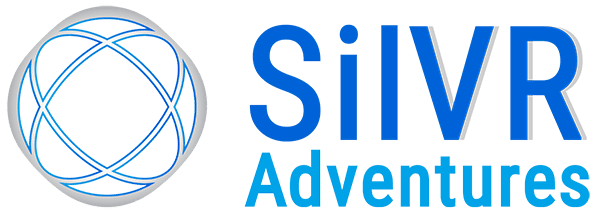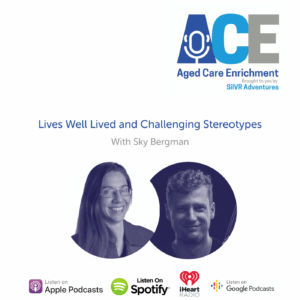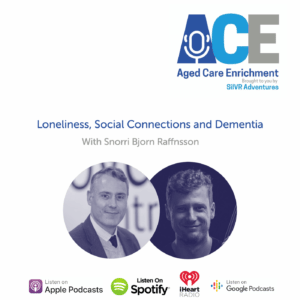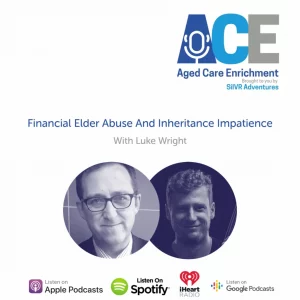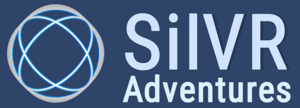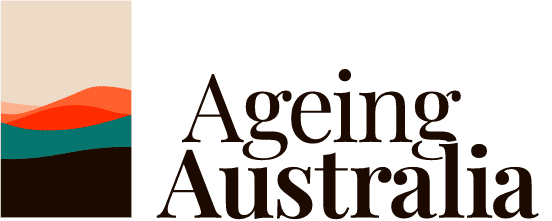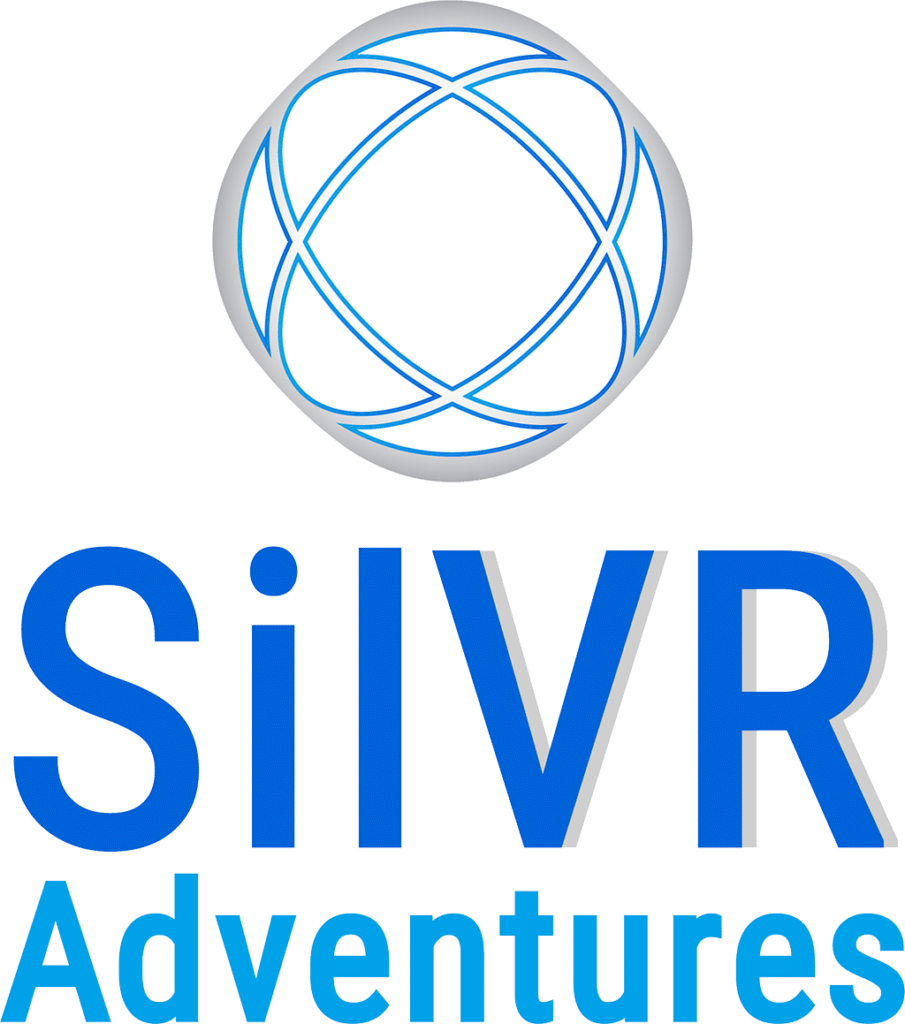Transcript
Ash de Neef: Chris, thanks so much for joining us on the show today.
Chris Mamarelis: It’s a pleasure. Thanks for having me on.
Ash de Neef: Yeah, we’re really happy to have you, could you maybe give us a quick intro to yourself and your work?
Chris Mamarelis: So I’m the CEO at Whiddon Aged Care. We are a large not-for-profit aged care provider. We’ve been around for almost 75 years now. We have a large footprint in region Australia, regional new south Wales and Queensland. We also have a large campus in Sydney, probably one of the largest in Australia with almost 500 residents that we’re caring for on site.
And we focus on residential aged care, home community care and retirement living. So we offer a span of services there as well, and I think we were pretty proud of the way we deliver our care. We’ve been innovating our model of care, we’ve pioneered relationship based care, we’ve also been involved in providing expert advice at the Royal Commission on a number of occasions as well.
So we’re pretty active member in the aged care community, as well as providing services to a lot of really important communities that were a part of.
Ash de Neef: Yeah, it’s fantastic. Listeners of the show will know that we haven’t really ever focused on COVID, we’ve skirted around the issue. It feels a bit like everywhere you look at in life at the moment it’s COVID all the time. But what would be really helpful I think maybe you can take us back to March 2020 and the arrival of COVID and maybe the first few months of adjusting to that.
What was that like in the facilities?
Chris Mamarelis: I’ve got to stretch my mind back because so much has happened since then. When you go back, obviously there was a lot of uncertainty at that point in time at the beginning of the pandemic we didn’t know what to expect. And we’ve seen these things happen before where they brush over and it’s more of an overseas thing.
But for us, I think as the level of risk started to increase, and we started to realize that this is impacting and we can’t ignore what’s going on, and the advice you’re getting from government and all of that started to ramp up.
I think the first thing you had to do, and remember I’m stretching my memory here. But I think the first thing you had to do was you had to take a bit of a new mindset. So all a lot of the things that you’re working on, a lot of the bigger plans, the bigger projects where all your resources and your people were focusing. A lot of that just came to a bit of a standstill. We’ve said we’ve been in survival mode for the last couple of years, I think as a sector. I know at Whiddon we’ve had to go into this sort of crisis/survival mode.
And that’s what happened. The team planning, structures, resources, all of that started to shift into this kind of crisis management, adapting to new protocols. you know, Things like getting PPE management to a whole new level to what we were used to. Different risk management protocols, team meeting structures, all this, huge level of change, and it didn’t happen overnight, It started to just creep in.
And then I think as we began to understand the virus the pandemic as science and medicine was catching up. And then we were being informed about that. So, you know, then vaccination strategies started to appear and we were really pushing to get all of our residents vaccinated and all that sort of thing.
I think it all just started to creep up on us. And I, think that with the first wave of COVID we probably went through, I guess, a six to 12 month period. And then that became operationalized. We operationalized that within about 12 months but this was pre Delta.
And we had that pause pre-delta where I remember even things like board reporting, all of that changed. And had this huge focus where you’re normally focusing on strategy and a lot of your innovation and your projects and your care plans, and a lot of that sort of stuff. It had this focus on the COVID crisis management and towards the end of that first sort of eight to 12 months, we started saying, “okay, we’re now starting to operationalize this.”
It’s becoming BAU, we’ve got all these screening protocols, PPE – it’s all becoming BAU. And we just started to get a sniff of being able to get back in and focus on what is most important. All about resident and employee-centric projects and all of that. We started to get back into that and I guess it wasn’t long after then this Delta wave hit us.
So that’s kind of my recollection. As I said, so much water has gone under the bridge in that period, so much that it seems like a millennium ago when all that sort of thing that was going on. But I guess that’s, my recollection of it.
Ash de Neef: Yeah. And I think the kind of shifting goalposts throughout it as well, and feeling like, “oh, we’re coming out. Are we going in?” What’s going to happen. So that lull in between the first wave and the Delta wave, did that feel, was there an optimism amongst the company that things might start to turn and we can put some of this behind us?
Chris Mamarelis: We’re very risk averse in aged care. It’s all about our residents and employees and our residents are so vulnerable. We’re in a lot of areas where community transmission’s been high, particularly in the Sydney Metro areas. So you started to get a little bit of optimism, but what was a little scary at the time was that the government and the regulators and the people around us just went very quiet on a number of fronts. And I think that, I don’t know if they were overoptimistic or what it was, but we started talking about complacency and that we can’t be complacent at that point in time.
So I think that we were a little bit on edge. We really had to continue that focus on residents and employees. Remember residents had gone through lockdowns and things like that, so we really wanted to bring people back into our homes. Visitations and all of that sort of thing.
So yes there was optimism. However, it was really about reinforcing that we can’t be complacent. And I think I was really glad that we took that approach because of obviously then the Delta wave came along.
Ash de Neef: Yeah, this is all very timely as New South Wales has just had freedom day and things are being lifted. I do want to touch back on that and in a moment and talk about the future. But beforehand, did we didn’t have any outbreaks in any of their facilities?
Chris Mamarelis: Thankfully touch wood, we had no outbreaks. We’ve had numerous close calls. We’ve had residents come back from hospitals who were exposed to COVID positive people, whether they be employees or, and we’ve had to isolate them and we’ve had to do things like that. But thankfully we actually haven’t had an outbreak in one of our homes. And I will say in saying that we had really put in a lot of additional protocols.
I say that to date, we’ve been able to achieve that through a lot of hard work protocols our practices as well, and there’s luck. There’s been some luck involved, because we have had plenty of near misses. Even in the first, outbreak my recollection is we had that Ruby Princess, we had actually someone come off the boat and breach a regulation and come onto the site and we had fend them away. And we’ve had some really close calls. But thankfully as I said, I think because of the hard work and with some luck so far, we’ve been able to keep it at bay.
Ash de Neef: Yeah it is early days and everybody is doing the best they can. Of course there is, there are factors outside of our control as well. I’m wondering then when you started in this process of… the pandemic is going to, be a real threat. It’s going to be a real upsetting factor in business as usual.
How did the regulations come from government and from other bodies to Whiddon and how are they interpreted? What’s the communication like there?
Chris Mamarelis: Look, I think that when you look at the first, maybe 12 to 18 months of this, government were learning. Obviously government were evolving practices, evolving strategies, modifying their directions, even on the legal front with the laws and things. It was all happening on the fly. And I think that’s understandable, it’s new territory.
So, you know, I guess if you look at, things like visitations and PPE protocols, there’d be some guidance that would come out. They would probably panel beat that among themselves. There’d be some industry forums at times where they’d asked for feedback from industry and eventually a decision would be made. Sometimes it took a bit too long to get that decision and you would have to act and just say well, bugger this, we’re going to do something.
And then the direction would come out. And then you’d get a direction just saying, employees must be wearing XYZ PPE, visitations are limited to this sort of thing. Or, you’d get those directions coming out. So it was this policy on the fly and it probably had to be given the volatile nature and the unknown. There’s so much uncertainty about the virus. That’s what we have probably seen for that first 12 to 18 months.
And maybe the last sort of six months, a lot of those practices then became embedded in what we’re doing. However, as we push on we need to start refining those practices in the new world we’re in now.
Ash de Neef: Yeah. So if this policy, you know, it’s a constant evolution and there would have been some times there was uncertainty and trying to protect your residents and protect your staff. Where were you looking to for guidance on the right step, if regulations weren’t at the point where you felt like they were enough?
Chris Mamarelis: Predominantly we work with our masters the Commonwealth government, so that we’re federally funded, federally regulated. So that’s usually your first point of call is working with federal agencies to get support. We also work quite closely with our state health counterparts as well. So in our case, largely New South Wales health and Queensland health. So there’s some interactions going on.
Then there are other, professional advisory groups all over the place, our peaks as well. So you’ve probably got multiple layers that you can reach out to. And, so that’s one layer.
What I’ve seen, which has been beautiful, and it’s always been a part of the way we do things anyway at Whiddon is we’re part of a number of peer networks, generally informal. So we, within the team, we have different peer networks and that was always just a collaborative group of people that work together and meet regularly to discuss issues, to help each other.
And that’s been something that’s been going on for a while. But what’s been really nice to see those peer groups coming together now during COVID and really helping each other, discussing different strategies, discussing different practices and collaborating and just sharing information. That’s been really helpful because there’s a lot of ideas sharing that was actually operationalized both ways that we were able to provide others and them to us.
And then we look to ourselves. And there were times where we just weren’t happy with – the rapid antigen test is a great example of that. Because the rapid antigen tests were this emerging technology, I guess that could be deployed and used in the fight against COVID. Or at least a really valuable tool to use in screening among the suite of other things. There was no discussion about it in aged care, it wasn’t available. No one was really talking about.
We found suppliers, we found experts in the field. We did it ourselves. And we went to government and said, would you back us in a trial, which they agreed to. And that was a really nice example of how we were able to bring an innovation ourselves to the table. Then from our trial, we saw the Department of Health then go try to conduct the trial with maybe over a dozen providers and then start distributing the rapid antigen tests at no cost to providers in the sector, out of a government stockpile.
That was a really good example of have we brought something to the table as well.
Ash de Neef: Cool. Yeah, that’s a nice give and take. I think if I was in that position, partly I would feel like it’s great that there is openness to communication and that you can bring ideas. But I would also feel like, my responsibility is to care for my residents and my staff. Why does it need to come from me and from my team to do something for the better everybody else?
Why is that? Not the leadership at the top to bring this in?
Chris Mamarelis: Yeah, look, I think it’s fair to say we have state and federal governments and regulators who are very well resourced around us. And there’s an expectation that they’re going to deliver on a number of fronts and they’re really going to support us to a certain standard and a certain level. I think that’s a fair expectation.
I don’t think it’s unreasonable for providers to be able to innovate and to bring things to the table as well, because I said we have different insights. We have different experiences, lots of different skillsets. And one of the most important areas is just coming from the team on the ground.
And I can give you one example where the government had changed visa restrictions at one point I think it was for students. Where they hadn’t, they had restricted hours, they were able to work and they said, “Hey, in this pandemic, we’re going to open that up and and so they can work longer. You’re going to have more access to clinical staff that were students.”
They put an expiry date on that. And so six months later I just had one of my managers say to me, “You know, if they just moved, got rid of that expiry date, I’d probably have access to another 18 full-time equivalent staff and that’s all they have to do.”
Now. I wouldn’t have known that so that you could feed that back up to the government and they actually changed it. We sent them some advice, they changed it and those little insights that you get make a big difference. So, yeah that was really valuable.
Ash de Neef: Yeah that’s a great example. Now you mentioned before this, the peer community, where you guys are exchanging ideas. I’m guessing this is probably across providers. Can you give us some specific examples of things that you’re talking about? Issues that have been brought up?
Chris Mamarelis: When I talk about those peak communities, just to give you an idea, so I’m part of a – it’s an informal CEO network with, up to 10 CEOs and we can. My COO she’s part of a network like that. And so on, you might have an HR network and a technology network.
And in our examples, their informal work, we might catch up once monthly. So through those sorts of meetings and sessions, we might’ve been talking – again the rapid antigen test is a great example of it. Because we started it, we had a lot of people in my network asking me, how’s it work? what’s the cost? what do you need operationally procedurally? So we shared a lot of information.
We ended up eventually doing a, paper cause we were part of a trial. And then, and we shared that with them. So rapid antigen tests was probably a good example, but you may discuss PPE, and what is the best in terms of staff? How do you get the balance right between protection, but also ensuring that we’re not cutting ourselves off from our residents from a wellbeing perspective? There are lots of discussions about that workforce strategies.
What are we doing to support our workforce retention payments. There’s lots of different discussions that are going on, and we’re probably meeting every month. So as the environment is changing around us, someone else would come to the table and say “well, look at this new direction we’ve got, how are you adapting that?”
And outside of that, I think you’ve got the professional discussions that are going on about strategies, about procedures and things like that. But for each of those peer networks those groups of people, just like the frontline employees, are under a lot of pressure, a lot of decision making, a lot of responsibility.
So just being able to check in on each other know, share experiences, I’m not alone in this. And so from, just from a wellbeing support perspective, I think it was valuable as well. And it still is.
Ash de Neef: Now, recently you put out a paper online about the lack of an integrated approach in dealing with COVID. Can you give us a bit of an overview of the paper and maybe what are some of the challenges that you’ve exposed throughout the process.
Chris Mamarelis: As freedom day really was approaching. So in New South Wales and in Sydney, we’d been in lockdown for, three months and we started to approach to this freedom day and people started talking about freedom day. And that’s where the restrictions were going to be dropped or reduced. And we were very supportive of that, It was time.
What’s happening is while the community is starting to free up. And while the community is starting to enjoy some new freedoms, there still remains a lot of risk, even in a double vaxxed society, to residents. Residents are still really vulnerable. We haven’t had booster shots for residents and residents were among the first to receive the vaccine, many months ago now. So we’re really concerned about the level of exposure as visitors come in, employees, all of that sort of thing.
So with that concern and that risk starting to bubble around, what surprised me particularly during that three months lockdown was that… We learnt a lot from the first 18 months, why wasn’t the health ecosystem coming together, federal state regulators, learning from what we had done in the past and saying, “we can do a better job” because we certainly can. And as I said earlier, I can accept the journey we’ve been on in the mistakes made through that evolutionary process.
But I think now we’ve had plenty of time bring and integrate our strategies and start functioning as one force to fight this battle rather than fighting this battle, through silos. And that’s essentially what we have. We have the federal government, we have the state government, we have providers.
And then within each of those silos, there are different layers. Federal government has Department of Health and the quality commission. State of health has got LHDs and the various bodies. Yeah. And it’s still to this day, we’re still operating in silos. And to me, it’s insane. I know, I totally appreciate that there’s legal ramifications. There’s red tape, but if this isn’t a time to bring all these groups together and fight the one fire on the one front, I don’t know what is.
Ash de Neef: That’s great. Can you maybe elaborate maybe on these silos and is it that there’s things of being doubled up on? Is it that there’s conflicting advice? Or is it a lack of communication between the different elements?
Chris Mamarelis: It’s probably all of the above. I think that when I draw on, some of these experiences that we’ve had in the past, I think that if we can get everyone together. If we can get state and federal agencies and regulators together and simply decide on protocols in terms of who’s managing what? Who’s taking charge of what front, on what strategy, on what direction? That in itself would be great.
So for example, if there’s an outbreak or if we’ve got areas of concern where we’re heating up procedures and protocols, you don’t want to be receiving directions from the department of health. And then you don’t want to be receiving additional direction from state health, and then the LHD giving you other directions.
You’d much rather, if you have an outbreak, you’re working exclusively with say state health, quality commission and the department of health back off to a certain extent so that you can manage that situation. And you can’t have two or three masters trying to give this one, one entity direction.
I think that there’s some really simple things that I think need to be addressed that aren’t being discussed. When I think of some of the regional locations that we’re in, communities are at risk. Resources are scarce in those communities, you might have populations of say four or five, 10,000 people even.
You’ve got an aged care provider and you’ve got a hospital and they’re the two largest employers. You both have assets and resources that can be shared. You both have laundries and kitchens, you both have skilled staff, registered nurses. If one or the other is in trouble, you should have a memorandum of understanding.
You should have a combined strategy to work together so that you understand exactly what each party is going to do. What we find ourselves happening is that there are shortages of staff. There’s no communication really about, “if you had an outbreak and you couldn’t use your kitchen well use ours, and here’s how it’ll all work and here’s the logistics around there.”
This sort of forward planning, which kind of seems very simple. It’s just not occurring in those situations. I think that this sort of collaborative strategies at a local level, they need to be endorsed by the higher powers. So you need endorsement from above and you need to put a blanket approach across the whole of your jurisdiction.
If you look at New South Wales, for example, that we operate in. There might be Eight to 10 different LHDs that we’re operating in. And there are inconsistencies across each LHD. Each local health district has a different approach or you get mixed messaging, despite the directions that are coming back from state health or the department of health.
So we can’t afford anymore really, I mean we couldn’t afford it previously, but as you go forward, you need to have all these things ironed out and there’s been plenty of opportunities. And that was really, I was calling out in this paper that to really come together and have a unified, integrated strategy across federal and state health. Working with providers to fight this fight going forward. It just doesn’t make sense that we’re not having those conversations now.
Ash de Neef: Yeah, it sounds like we’re still in crisis mode and it’s still a scramble to get whatever done that we can as quickly as we can without a thought for the efficiency. Looking to the future now and, and past freedom day it strikes me as, it’s not really freedom day for a good portion of the society. And especially for our industry. Not much is going to change immediately is it?
Chris Mamarelis: Not drastically. But if you look at visitations, for example, we’ve opened up visitations, but there’s still some restrictions around that. You need to be tight on PPE, on your screening protocols on clinical and infection control practices. This isn’t going away anytime soon. That applies to a supermarket now, let alone in a very vulnerable aged care home.
So having gone out to our home this week we made the decision with our employees, at least in the initial weeks freedom day, we’re in really heavy PPE. We’ve really equipped them quite heavily in PPE with screens, with P2 masks. So we’ve gone over and above what’s required because we’re just concerned about this initial risk and we’re going to monitor it.
So it’s not going away for aged care. I’m really concerned about the regions, in terms of the resources out there in terms of being able to service the community, not just aged care. But if we have an outbreak and an aged care is relying on the local hospital, which is typically small, that really concerns me as well. So I think again, state, federal governments we really need to have a focus area in these regional communities to make sure we’re doing everything we can to prepare.
And sometimes I look, I’m not a preacher of doom. Sometimes I hear myself and I think, “ah”. It’s not about a looking at it through, in this sort of dark frame or dark lens. But when you’re responsible, which is what I am, the buck stops with me for over 2000 people. Whether we’re caring for them in our homes or at home. And three, nearly 3000 employees. And I look at the regional community, some really vulnerable places like Burke and Walgett and Wee Waa, which are really vulnerable communities in terms of the resources and the assets they have out there to support them. I will always take a very risk, heavy approach to protecting those people. So just put it out there. That’s really the angle that I’m coming from.
But yeah, we have a lot more to do. We’ve got to be cautious, we’ve got to take steps. I think the other piece that needs to be called out, which is what’s always been there is well-being. Well-being of residents, and well-being of employees. And having walked around our home and go on and visit some of my friends, some of the residents that I know there quite well this week. It’s so, um, disengaging having a P2 mask on and I wear glasses and then I’ve got the screen over me um, the face shield over me as well.
It’s very disengaging. And a couple of people I know really well, they said, “who is that? Who is that?” And I had to say, “it’s Chris”. It’s very hard, but I guess we’ve kept them safe and we’re just trying to get this very delicate balance right. So I think that if community transmission, as we see community transmission start to decline. As we see a positive impact from double vaccination in the community, then I’m hoping we can slowly step the levels of normality up in the aged care setting. But we have to be cautious and it will take a bit more time.
Ash de Neef: Yeah, absolutely. And thank you for outlining that balance of I’ve often wondered about that, that you need to, you do need to preserve wellbeing and make it a life worth living wherever the person is. But you need to keep people safe as well. How have you guys approached keeping people connected within communities and keeping life entertaining within a home?
Chris Mamarelis: Yeah well, it’s not been easy. I mean, I remember in that first way we called them risk-free visits, and a lot of providers started doing this. Where you were using our windows and glass barriers and things like that to facilitate the families coming in and visiting and all that sort of stuff.
We brought in some technology. So we were part of a development of an app, that needs support. So residents still need support, they’ll need a person to help them launch it in many cases and things like that. But the app provided that sort of Skype/FaceTime sort of functionality so families could connect while they were locked down.
We sort of supported a lot of different communication practices between families and residents as well. So I guess you’re doing as much as you can, but the reality is, and I need to call this out. It’s not perfect. I don’t think that – I would have liked to do a lot more. I would have liked to seen a lot more happen. I’m sure a lot of other providers would have liked to do that as well.
The two things you have to factor in, or maybe three things is that one borders shut. So we lost access to staff. We started seeing workforce furloughing, staff having to go into self quarantine and self isolation cause of exposure.
And we saw a sick leave in attendance. Attendance, go down, sick, leave, increased. Because there was apprehension, people had families at home. I can’t blame employees for that. So rosters were really under a lot of pressure.
And on top of it, you had all these sort of operational challenges. So people had to work harder, were doing other jobs screening and things like that. So the workforce was really under pressure. And when they’re under pressure things like activities and those sorts of areas – the reality is you probably can’t give them the focus that you want.
And from a Whiddon perspective, we pioneered things like relationship based care, a whole stack of different programs. We revitalized our model of care. It’s the reason that we exist. It’s what we wake up for every day. This has been really hard, because it’s very hard to push your people that hard to say, “we need to do more on the well-being front. We need to do more activities”, when they’re already short-staffed and under pressure.
So we tried to get the balance as well as we could. We couldn’t bring volunteers in to help either. So it’s a challenging situation. Anyone tells you they came up with a perfect solution is kidding themselves. If we had access to more workers, if the volunteers could have come in and we had the borders open, it probably would have helped.
I can’t believe when I look back we still managed to do, we launched a cooking program with residents during that period as one example. We ran a couple of other programs as well. We still managed to have a lot of celebrations for different events that occurred during the time. But obviously it was a condensed version of what we normally would have done.
So yeah, that putting that well-being of employees and residents at the forefront is, has always been important, but very challenging during this time as well.
Ash de Neef: Yeah, absolutely. Chris, we’re almost out of time I wanted to ask you going forward for the next six months. What are you and the leadership team looking towards? What’s on the horizon do you think?
Chris Mamarelis: Well, Interestingly enough, and probably not dissimilar to that conversation we just had about well-being. I really want to see us get back to some level of normality in terms of our strategy and our directions as an organization. So Whiddon as I said, we’re a not-for-profit organization, we exist for two reasons, our employees, our people, and the people we care for. That’s why we exist.
And in this survival mode over the last sort of period of time, a couple of years, really, we haven’t been able to really engage as heavily in some of those directions that we had on the cards. We had a number of care programs, different care programs, innovation that we’ve been working on. We’ve got new developments that we’re working on as well.
So we’ve got a whole host of employee-centric programs as well. A lot of this stuff had to take a backseat because of the crisis management. So what we are trying to do is, as best we can operationalize the COVID management, the COVID strategies, operationalize that while ensuring that we’re doing our very best to minimize risk.
But at the same time, we’re trying to breathe life back into our purpose, breathe life back into our strategies and get those things back on the table. And, if a quarter of our time has been spent on that in the past two years, because you know, 75% has been on crisis management, I’d like to see that become 50, 60, 70, 80% as we go forward.
Because that, again, that’s why we exist. Obviously we’re dependent on what happens with COVID. Are the new strains? what happens with community transmission? How well do we manage it? How well is it managed around us? But also I said, I think that if we’re serious about the people we care for and the people providing that care, those people around us, that health ecosystem has to come together now and do a much better job going forward.
We understand what’s happened in the past. We need them to come together to a much better degree to support the industry as a whole and our residents and people going forward. So I think that we are dependent to some extent, but Whiddon will always do our best to control our own destiny as well.
And we need to come back to some of those key strategic directions now going forward to benefit those key stakeholders – our people are now and our residents.
Ash de Neef: Yeah. Fantastic. Chris, thank you so much for your time today. Where can people find out more about what we’ve been talking about and the report that you released recently?
Chris Mamarelis: Yeah. So the report itself, I’ve posted that on my LinkedIn you can just look up Chris Mamarelis on LinkedIn, and you’ll find that in a lot of other stuff on Whiddon. There’s also a lot of information on our website, Whiddon.com.au. You’ll be able to find some information there and any sort of searches should be able to take you to Whiddon.
And I believe that there’s a lot of work going on in the background. Let’s just keep our fingers crossed that it doesn’t take months. Over the coming weeks we see some action and we get some positive results for the benefit of the whole industry.
Ash de Neef: Yeah, fantastic. Chris thanks for your time today.
Chris Mamarelis: Pleasure Ash. Thank you.
